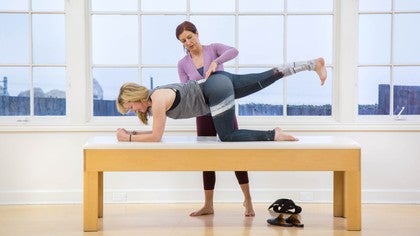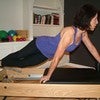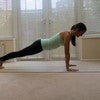Description
About This Video
Transcript
Read Full Transcript
Hi, today, I would love to give you the tools and tips you need to do the let's get started program on Peloton anytime. Even if you have a weak hip or weak knee. What do I mean by a weak hip, hip, or knee? Um, it is not something that is an acute stage that you just injured or maybe have been suggested for immediate surgery. You don't want to be doing this class. This is not the class for you. This is the class for someone who has been recommended to do some stretching and strengthening for their hip or their knee, and that is going to improve their quality of life.
If you've been advised to do more stretching, maybe you have a really tight hip flexor, so as someone has told you, you would really benefit more from stretching, then you might want to check out my class number three, three, three that emphasizes more of that. Then the let's get started series, which is going to be stretching and strengthening and every single exercise. The idea is to strengthen the whole body because after all the foot, ankle, knee and hip have a ripple effect on each other because they're all connected. So let's talk a little bit about that. It's really important to understand your leg, your hip, and your knee and how it's all related to and what is healthy and strong and what affects each joint. So if you have a bad ankle, it could possibly be with something in your foot, the way your foot is, how it's just whether you roll out or roll in, obviously for the ankle, but just maybe if you have a Bunyan or just how your big, your big toe and little toe, all the toes go down.
It will affect your ankle and then moving up the leg you have your knee. So if you have some, if you're rolling in on your net goal rolling out, then it's going to affect the knee. Pretty common sense stuff here. And then if the knee is rolling in or out or we have knocked knees or bow legs, it's also going to affect the hip. Now those are all the knock kneed or bowlegs. Those are big things. And same with the ankle I'm rolling in now, pronation, uhm, or sip nation, all of those are big things to change that definitely you would be in better hands working one on one knowing exactly what you need to correct to fix your imbalances. But this, these classes going to give you a really good foundation on what to do.
And so you want to pay attention to the details in the let's get started series when I talk about barbershop polls, super important. That's gonna really help you strengthen your glutes and your outer thigh and even your inner thigh to help support the knee joint, which will and have that beautiful ripple effect down on your foot. And I will talk a lot about Pilati stance and how it doesn't start like a ballerina might want to just turn out her leg, but really using the muscles take a long time to develop a good dancer. And so same with the employees here. We're going to be working on that. So common sense number two, besides all of those things I was just saying is wherever your knees point, wherever your toes are pointing, your niche should point.
So if my big toe and through my little toes are pointing straight ahead, I'm gonna want my need to point straight ahead. Okay? And if my toes are turning out a little bit, then I'm going to want my knees to turn out a little bit and they're just going to keep going that way. And most exercises in piles, we're not gonna do more than this type of turnout, but you just want to take a glance and think about what you do in daily movement and how you hold yourself, uh, are your feet may be parallel and your knees rolling in, and then you have hip point pain or lower back pain. You want to look at these things. So try to keep that in mind. If you want to strengthen your knee, if you want a strength in your hip in [inaudible], then you're going to want to really pay attention to your alignment and when your leg is straight, are you straightening it with your knee rolling in while your feet are turned out or are they really turned out? Try to get all of those points in alignment.
Really helpful to help strengthen you. All right, so let's begin by lying down and assessing our range of motions. The first thing we're going to do that I talked about in the intro, we want to find out exactly what aggravates our hip or our knee and how we can avoid that. Something I can't show when I'm on my sitting down though is there are different ways that your knees, so let's leave the hip out. If you have a bad knee or a weak knee, I should say. How does it hurt? Does it hurt?
Only if you would kneel on it like just thinking about and kneeling down on your knees makes you want to your eyes water and want to cry. Then weren't, don't ever do any exercises and polities that require you to be on your knees. There's a lot of kneeling exercises as you advance in Pisces, or maybe you just need extra cushion, extra pads underneath your knees while you do those exercises. And that's fine too. Or does it hurt when you're doing something? Some form of flection. So if your knee is coming, this is easy to demonstrate. I'll show you again when I'm on my back, but maybe that really hurts you.
You can't bring it more than a 90 degree angle or maybe that doesn't, but it hurts you to bring your foot towards your bottom. Seeing me do this might bring tears to your eyes. So think about what that is. If it is bringing your heel towards your bottom, you're going to want to be really careful when you're lying on your stomach, what exercises you do. Now, I'll go over those in a minute. So obviously your exercise, Matt's going to be really low to the ground and not that fun to get down on. If you have a bad hip or knee, weak, weak, I should use that word instead of bad, but lower yourself down however is comfortable for you and check out our body and see if there's any other little areas that might pop up because of our hip or knee.
So even though we are talking about a weak hip or a weak knee, we are going to check all our bodies so that to make sure that we do not have any other pain anywhere else. So let's start with our right arm. Is it okay for you to lift up your arm? How about if you take it back? Did that bother your shoulder? Did it bother your back? Lift your arm back up and then bring it right back down to your side and all that feel. Okay. Um, what about if you circle the arms? So we're going to bring the arm up and open it out to the side.
Does that feel okay on everything and then bringing it down. What about if we reverse it? Maybe you might have a little neck pain. Would you want to just really pay attention to our body and get the feedback that we want? Let's try the other arm. So as we're going to lift it up, feels okay taking it back. No problem at all. That's good news. Bringing it up or maybe it gave you some feedback. Bring it back down and we're going to bring that arm back up and let's circle it out to the side and bring it down to your hip. And this hope series.
I also have classes, um, talk about how to deal with the shoulders. If your shoulders hurting you during this, bringing it up to ceiling and bringing it down. You can look at what tips do I have on there or let's also your neck. So if you're lying down right now and you're looking way behind you, it's very common. You are going to want to fold up a bath towel and put it underneath your head so that you can be nice and looking straight up at the ceiling or even better a little bit this way, having the back of your neck very long and not pinching on any nerves.
Okay, so we checked out your arms. We have some feedback from our shoulders, our neck while let's go ahead and see. Can you lift up your head to your chest and it does it bother you. So I'm going to always use my powerhouse, but you're going to be learning how to use that. So when I pull it up, does it hurt? Well it would if I hold it here. So be careful when you're learning polis that you're not going to do that, that you're going to hold it as if your whole head could be in your belly and then go ahead and lower it down. And I want you to take note. Did that bother your neck at all? Maybe it didn't hurt in the beginning, but after a few seconds you felt at tensing up.
So you'll want to listen to all my details and cues in the Syrian and the let's get started series about how long to hold your head up and when to lie it down. Okay, now we're getting to where we really need to get to, which is from the waist down. So we will go over again in the let's get started series many details and this one's super, super important for you. And that is the politeness box where you have a straight line from one shoulder to another as well as a straight line from one hipbone to another. Okay? You want to make sure that this alignment is straight across and right underneath the shoulders.
So you're going to be paying attention to learning how to make sure that that is happening when you're doing your Polonius work. That's important because it's gonna Affect, just like I was talking about a moment ago while I was standing, the ripple effect, if your hips are off, it's gonna really affect the rest of your body as well. So let's see, does it hurt to bring in your knee right above your hip bone, making a 90 degree angle with your leg? So we're gonna pull our belly and always, but does this hurt your knee or your hip? It's super important to just do small range of motion, small movements because you don't want to scare your body or make it feel like it's going to hurt.
It's probably been through a trauma or an injury and you're not really happy about hurting it all the time, so don't go right away for bringing the knee to your chest to test this out. You want to be keep tell your body, I've got this. We're confident, we're going to build trust. I'm going to just bring my leg up so that it's right over your hip and you're trying to feel, does that hurt? Because you can do so many of the Belarus exercises with your hands under your knee like this and the knee just over the hip. In this 90 degree angle and little by little as your stomach, your powerhouse gets stronger and you become more flexible.
You'll be able to pull in a little more and a little more and a little more and you won't have any pain. That would be a goal, but you don't want to force it from the beginning. So I would love for you to take note right now and get some feedback. Did that bother your hip at all? Maybe it didn't and you could bring it all the way in. Did that bother your knee at all? Maybe it didn't.
You could bring it all the way in, but wherever it was, take notes so that you keep yourself in that range of motion when you're executing the exercises. All right, so we're pulling in the leg and we found out where was our range of motion that did not cause us pain and we were happy and doing exercises getting stronger. Then I want you to straighten the leg and I want you to put your hands behind your thigh, never the knee joint. And I don't want you going up as high as the calf did. That bother your right hip at all. If your hands are here, is it really clenching in here? And you need to go back to that stretching class I mentioned earlier.
You want to feel what the body's saying, right? How's that bother your back at all? All right, let's see if your knees okay and your hips. Okay. Let's put your arms down and draw a little circle. So I talked about our box and it's super important. We're going to stay within that box.
So we're going to draw a little circle towards our left and down a little and back up. Did that hurt anything? Let's go the other way down a little bit. Cross back up. Okay, let me know. Let yourself know what, how did that feel? What went on? Let's try the left. We're going to pull our belly in. Bring that left knee just over our hip or as deep as it felt comfortable.
Then we're going to straighten the leg. Also, take note of your flexibility. Is that super tight? Is your leg like that and it does straight as you can get it or were you able to straighten it or was your, is it your knee? That's a problem and your hip is so flexible that you're practically doing this splits here. Pay attention and figure that one out so that you can do your exercises safely as well. If this is okay, then we're going to put our arms down and we're going to circle towards our right. Crossing the body down a little bit and back up. How did that feel?
Go the other way down. A little bit. Cross towards your right and up. Good. And then just figure out what, how is that feeling on your body? This is to test your range of motion and what give you confidence to do a pain-free beginner mat. All right. Another thing when it comes to the legs that you want to check is how low you can take your legs. So we're going to go here and up here and because we don't have a bad back, we might be able to lower our leg pretty low.
So we're gonna reach it towards the ceiling and let's see if I lower it so that my thighs are at the same level. Does that bother my hip? This is more for a hip than a knee. What if I went down so that my leg is at the same level as my calf on the other leg? Does that bother your hip? What if I lower it so it's just hovering over the mat? Does that bother anything your back maybe at this point and you're going to bring that leg back up and then bend the knee where it's comfortable and put the foot down. Same thing on your left leg.
We're going to bend the left knee in bending it to where it's comfortable straightening the leg to where it's comfortable, reaching it long to the ceiling. As our belly pulls in, we're going to bring that leg down so that that's at the same level as your left. Your right. I apologize. Quad, so the thighs are at the same level. How does that feel? Um, can we go a little lower? We're going to see if that left hips. Okay. If I bring it so that the, the level of my right calf and what if I bring it a little lower? Definitely stop as soon as you feel any pain. This is not a no pain, no gain. What if I have the leg at just hovering over the mat? Is it still okay on your left hip, on your back?
Is your right hip trying to control it? Take note and have all this feedback and we're going to pull the leg back up and bring it in only where it's comfortable. I just corrected myself because my hands were here. We're going to go over that in just a moment. So we've checked our range of motion, we have figured out where we can take our legs down too, if there's any pain, how deep can we bring in our knee?
Very important. Uh, we've learned how to do a little circle, very important. So all those things are setting us up for success. We know what our range of motion is without having any pain for our beginners series. So now that you know your range of motion, we are going to go into the modifications and exercises that you would need to omit if he had a weak hip or weak knee. Now the exciting part about it is there's hardly anything that you need to omit. Mostly everything would just be a modification.
So that to me is really exciting and encouraging. So the first exercise, and I'm not going to teach them to you, this is more of a tutorial on the modifications and what you need omit to state safe. I go in such detail throughout the series that you definitely don't want me to keep doing that right now. So the first exercise you're going to see is called the hundred and your knees are going to be bent and right over your hips and you're going to bring your head up and pump your arms. So when you learn it, it's going to be like this, and this is fine. If you have a weak hip or weak knee, then we straightened them and I want you to pay extreme attention to barbershop polls. When I describe them in the class, I don't want the legs straight up at a 90 degree angle. I would want you to make sure that you extend them forward a little bit when you're doing that and really having that beautiful ripple effect.
All right? Making sure you're strengthening your powerhouse and whenever you stretch, even after the hundred you're going to put your hands always under your knees. The next exercise that you're going to come to is a the roll back, and that one absolutely is great for you as well. I'm just going to rock right up to a seated position so that exercise starts off like this and you're going to have your knees. For most people. This should have no consequence on your body.
If you have a weak knee or a weak hip, it would. If you're kind of sitting here and you have a week hip, so you're always going to try to create as much space between your belly and your thighs. Even if you have a weak knee that's excellent for you. So when you do the rollback really exaggerate that am as you come back up, really pay attention to keeping your belly far from your legs. The more distance, the more stretch, and then the more strength you'll be able to.
The other thing I want you to think about when you're doing that exercise is really pressing the legs together and trying to engage the glutes so that you're hugging a midline. It's super important for a hip or a knee to use your legs for stability and to hug a midline. All right, the next exercise is single leg Sur a circle. So I'm going to go down and we're going that bend the knee in again, bending at your comfort level and you'll end up stretching the leg again at your comfort level. And you're going to really focus on reaching up to the ceiling. Really focus on keeping this alignment.
It is all in the details of this pelvis. If you can circle your leg without moving your pelvis and learn how to use your powerhouse to do that as well as the leg muscles. You are going to be on a road to recovery and I'm really excited for you for that. That's for your hip or your knee. Okay, so you're gonna end up learning how to do circles and they're going to get bigger and you're gonna make them keep them in the range of motion that is healthy for you. I want you to really try to get out of gripping in here. I talk about it a lot in the, let's get started and I'm just going to show you again on this leg is just wonderful for you to learn the barbershop pull muscles and how to keep your [inaudible] box because that is going to strengthen your hip and your knee versus I'll show you what not to do versus rolling around with the whole pelvis.
And I talked about if your toes are pointing one way, so you're not going to be doing the leg circle like this because we're going to be working those barbershop pull muscle. So all of those little details are just going to do wonders for you to strengthen your hip and your knee. All right, so the next exercise would be willing like a ball, which one day you will be able to do, but when you do it, I'm going to want you to keep your hands underneath your knees so you'll end up coming forward. Again, as much space as you can keep between your belly and your thighs. Don't come here. Always stay here to help, not pinch up that hip and you're going to keep your hands under your knees for a long time when you're doing these exercises, so when you roll in, rolling like a ball, it is not going to be tight like this, nothing like that. Instead, you're going to round your lower back, pull into it and have some good distance and this is very healthy for you. Then the next class exercises you're going to come to will be the series of five. And again, super exciting that you can just keep doing all these. You don't have to omit anything for a week, hip or knee, but you should pay attention to those barbershop pull muscles that'll help teach you how to lengthen your leg out of your hip to get some circulation in there and heal that hip.
So single leg stretch is done with your hand, right hand on your ankle and the left hand on the knee. This is super important once you have no pain in your knee, joint or hips. So if that's you already, great, okay? If it doesn't hurt you, you can have your hands like this. The majority of you will not be able to do this. We will one day get there, but this position is super important and I'll go over it in the class again because there's a straight line from your ankle to your knee to your shoulder and it works with the hip versus if I had my hand switched and my leg was out and I did the exercise like this, that would be not healthy for my knee or my hips. So when you do it, make sure you paid great attention when you get to this point, this level of your hand placement, but for now when you're learning [inaudible], we're going to be having the hand underneath the knee, keeping that right angle or wherever felt good in your hip and knee and the other leg is going to work on stretching and lengthening out your hips. I'm going to pull my Ali and just show what that looks like. This legs reaching an opposition and reaching really good for building strength.
Really good for stretching. You're going to pull that knee only where it feels good. Maybe it's here. Okay, very important. Same thing for the next exercises, the double version of it. Your arms will end up being here, but they're going to circle back just behind your only where it feels good, the leg they're reaching out of those hips in with barbershop, Poles and Kay. So if when you get at without pain instead of here, maybe you're a little more here, maybe you're here, maybe you're here, and then eventually you'll be here. All right? The next exercise is the series of, I'm sorry, the single straight leg, and you can have your hands right here or maybe behind the calf, okay? You don't need to bring the leg all the way up here.
You're going to have it where it feels in your comfort zone for that range of motion you just tested, right? But such great legwork and strengthening for you, even though it's all about the powerhouse, of course. And then the double version is double straight leg. Your hands will be behind your head, okay? And you're reaching all so good. So good for developing the outer thighs, inner thighs and the powerhouse. But you don't need to take it too low.
Just keep it within your range in the beginning. And finally the crisscross. We're going to bend the right knee where to where it feels good and the left leg is reaching. So say it's just right there and then twist up up, up, and then the other leg. Or maybe you can bring the knee in a little further or a little further or a little further. But this knee and this one reaching out is so, so important. So again, you get to do all the exercises. You just need to pay attention of your little notes that you took on your range of motion and what feels comfortable for you.
I'm not going to go through all of the exercises, but do you know that when you sit up for spine stretch forward or for saw, here's spine stretch forward here, saw this might really hurt you. So you might need to bend the knees a little bit so that you can feel your belly lift your spine up instead of gripping in your hamstrings because your of your flexibility. So pay attention to what you're good range of motion you have there. And then open leg rocker is in between those really, really great exercise for you to learn how to hold your legs up from your belly. So you might live in the prep for a long time.
If I have to say omit something, maybe it's the full open leg rocker. This extending one leg at a time without moving your Pilati box is so good for your powerhouse. So good for that hip joint. Maybe you can extend both legs, but your hands are behind your knees. So I'll switch my hands there to show you always pulling my belly away from my thighs. Maybe your legs only extend to here. That's great. You want to work on that exercise to help strain.
Don't go into the full open leg rocker for a long time. Uh, then when we flip onto your stomach, you're going to want to be careful if you have a bad knee. So I mentioned that in the very beginning. Maybe it hurts your knee when you're bringing your heel to your seat. So in these exercises, when we do single leg kick, you'll see it like this. And I want you to kick one leg and the other.
That might bother your knee joint a little bit or maybe I don't think it'll bother your hip, but it might bother your knee joint. Leave it out for a little while. Work on stretching your quadriceps for a little while. When you do get to it cause your powerhouse is so strong and your bottom is so strong, take it only to where it feels okay. You don't need to take it in all as far as you can work the muscles, feel the strength developing. Don't go to the pain zone.
That's not where we're going here. Same thing with the double version of that. So both heels would be coming to your seat and that would be very painful for you. Let me show you on the other side again. So here we would maybe just take the legs to hear feeling these contract rather than lifting higher rather than pulling the heels all the way in. You really want to find where it's comfortable for you to work safely. I'm going to stretch for a second.
And then the only two other exercises I would like to mention is are the teaser and the teaser actually you learned starting from one leg teaser, one leg, which is great. It's the rollback. So here you're learning, how can I hold my leg from my powerhouse? It's the roll back with the leg up. Then you do the other leg. So you're really learning how to hold from here, not from here. Takes so long to develop that strength and then you do it with both legs up and you really want to hold from here and pull that powerhouse back as you do your teaser.
Finally we learned the seal and the seal is safe for you as well. Even if it hurts your hip. Of course, leave it out, but your knee should be okay. And again, it's really with your waist pulled far, far, far away from your thighs. I always like to think as if my stomach and my thighs are not friends and I have to keep them as far apart from each other. And you should be able to do seal with that. You don't want to be super tight, any of that soup for tight contraction, that's going to not feel good for you. So we want to be careful with that.
In the seventh class of the let's get started series, it's actually class number two, five, seven zero. If you ever need to jump straight to it. I introduced the magic circle and that's an absolutely invaluable for you. For a weak hip or a weak knee, it really strengthens the glutes. It really strengthens the hips and the inner thigh and the outer thigh and always your powerhouse. In fact, I love to call your powerhouse circle. Uh, but more importantly, it gives you a midline, which is vital to finding your stability in from your waist down.
So helpful developing all of your strengths. I can't recommend that class enough probably to be repeated and repeated because some of the classes, as I mentioned in the Intro, you should redo and you should go at your own pace and really pay attention to the details. So for a quick recap, I get super excited about a week, hip or knee, because there hardly is anything that you need to omit, just need to know your modifications for your range of motion, which I think is encouraging and exciting. And then you want to focus on those barbershop pull muscles and developing your powerhouse within your Palase alignment. So now you have all the tools you need to do the let's get started series, even if you have a weak hip or weak knee. So let's get started and let's get strong.
Tips for Teachers: Working with Contraindications
Comments
You need to be a subscriber to post a comment.
Please Log In or Create an Account to start your free trial.


















